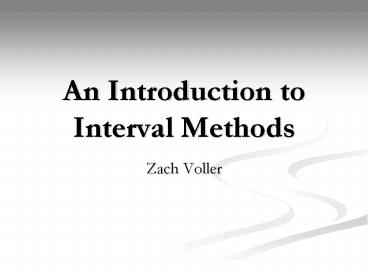An Introduction to Interval Methods - PowerPoint PPT Presentation
1 / 31
Title:
An Introduction to Interval Methods
Description:
These errors leads to an overestimation of the range of the function values may ... Scalar distribution does not hold when the scalar is an interval. ... – PowerPoint PPT presentation
Number of Views:47
Avg rating:3.0/5.0
Title: An Introduction to Interval Methods
1
An Introduction to Interval Methods
- Zach Voller
2
Basic Notation
- An interval is defined to be
- where is the infimum of and
is the supremum of - An interval is thin if
- An interval is thick if
3
Order Relations for Intervals
- Let then
- Thus
4
Examples
- Some clear relations
5
Elementary Operations
- Let then
- Notice that this restricts our definition of
t o be - defined on intervals such that
- Most elementary operations can be defined just by
using the endpoints of the intervals
6
Examples of elementary Operations
- Note the following examples
7
Elementary Functions
- Elementary Functions are members of a predefined
set of real function that are continuous on every
closed interval that they are defined on. - Some examples of elementary functions are
- (this is magnitude, not absolute
value)
8
Rounding Error and Interval Methods
- The way a function is defined plays a critical
role in determining if the calculated interval is
an accurate estimation. - This is due to the memoryless property of
interval methods
9
Example
- Let
- Then,
- but,
- where is the outward rounded value of
10
Rounding Error (ctd.)
- This error is due to the fact that the variable
- occurs more than once in the function
- Theorem
- Let be an arithmetical expression in
- if each variable occurs only once then,
- for all
intervals in the domain of where
is the tightest interval containing
.
11
Rounding Error (ctd.)
- Thus the challenge is to change the expression to
an equivalent form with only one copy of each
variable. - This can be done by methods like completing the
square or other transformations. - These errors leads to an overestimation of the
range of the function values may become extremely
large over the set of intervals
12
Error (ctd.)
- While the overestimation may blow up over a set
of intervals, it will remain small for
sufficiently narrow intervals. - We can bound the range by considering the
deviation of from a fixed center (often
the midpoint of the interval).
13
Computing a bound for the overestimation of the
range
14
Mean Value Form
- Let be the midpoint of the
interval . - then by mean value theorem we get that
- () for
some , thus - and we get that ()
- Thus the Mean Value Form
- is obtained.
15
Example
- Let then we get the
following values
16
Example (ctd.)
- Thus we see that the Mean Value Form is a more
accurate approximation for narrower intervals. - Note In the previous example I did not take into
account the rounding error for . Since
computers can only calculate a finite number of
digits, the approximation will be slightly worse.
17
Mean Value Form (ctd.)
- It can be shown that for narrow intervals the
Mean Value Form gives a better enclosure for the
range of the function than simple interval
evaluation. - There are other very similar methods that all
involve a fixed center value in the interval. Any
of these methods satisfy an overestimation bound
that can be easily checked for acuracy.
18
The Error Bound
- Let be a real function,
an interval in and let . Suppose
that is an n-dimensional vector such that -
for some - then, the interval encloses
the range of and the error bound is - I need to work on this to further understand the
proof and how to efficiently calculate this!!!!!!
19
Interval Matrices
- Let
- be a (m x n) interval matrix where each is
an interval. We now define
20
Interval Matrices (ctd.)
- Now note that we can redefine the matrix interval
as - Interval Matrix Addition and Subtraction are
defined as before where the entries of the
interval matrix are added or subtracted component
wise. - All the normal properties of matrix addition
hold. (i.e associative, commutative)
21
Interval Matrices (ctd.)
- We need to be careful with scalar multiplication
since the scalars can be either a constant or an
interval. Scalar distribution does not hold when
the scalar is an interval. - Let be interval matrices, and
an interval over the reals then,
22
Example
- Let
- then,
- And for scalars
23
Example (ctd)
- Note but is
not in - thus,
24
Linear Interval Equations
- A linear interval equation with (m x n)
coefficient matrix whose entries are
intervals and right hand side an (m x 1)
interval vector is the family of linear
equations - such that
- The enclosure of the solution set is denoted by
25
Linear Interval Equations (ctd)
- Typically, the structure of the solution is
complicated and is usually not an interval
vector. - We denote the hull of the solution set
- This is the interval that all solution are
contained in. - If is an invertible square matrix, then
- has a solution
26
Solving a basic linear system
- Let be a (m x n) interval matrix over the
reals, then
27
Solving a basic linear system (ctd)
- Theorem
- Let be (m x n) interval matrix over the
reals and a (m x 1) interval vector over the
reals. Then
28
Example
- Let
- then,
29
Example (ctd)
- Now,
30
Example (ctd)
- Thus,
- Plotting the solution we get
31
Graph































